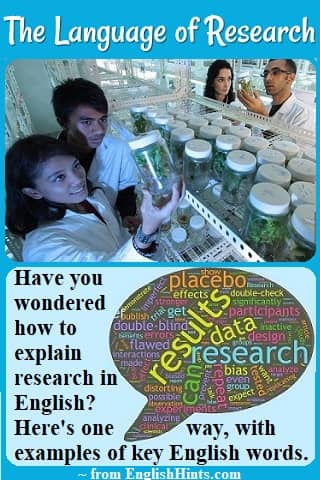The Language of
Research:
an Explanation and Examples
Learning the language of research can help you understand research answers to important problems. It can also help you read academic texts (and tests) more easily.
This page explains key words for understanding the process of research. It talks about what can go wrong, leading to false or misleading results.
Then it links to several examples of research, so you can see how scientists use these words.
At the bottom is a link to a crossword puzzle. Use it to check your understanding of many important words used in research reports.
The Research Process
Research starts with a question or a problem. Researchers first find out what others have already learned about the subject.
If the question has not been fully answered, they figure out a way to get more information. They may do further observations or perform an experiment to test their idea.
Next they analyze the data (information) they have collected. Then they publish their procedures, data, and conclusions. This allows other scientists to repeat the experiments and double-check the conclusions.
The “gold standard” (best proof) of clinical research is a double-blind trial. That is an experiment with two (or more) groups of people in which only one group receives the drug or treatment being tested. The other group gets a placebo.
(A placebo is a “sugar pill” or other treatment that looks and feels like the experimental treatment but has no active ingredients. Any effects it has are psychological—because the participants expect it to work.)
A “double-blind” experiment gets its name because both the researchers and the participants are “blind” during the test. Nobody knows until the experiment has finished which group got the treatment and which group got an inactive placebo. That helps prevent people's expectations from distorting (twisting or changing) the results.
The treatment being tested should give significantly better results than the placebo. If not, any apparent difference it makes may be due to people’s hopes and expectations. So a double-blind trial is a way to check the effectiveness of a treatment.
The Language of Research: Describing Problems (Bias, Errors, and Distortion)
The Language of Research: Describing Errors
There are several reasons research results can be misleading. There may be flaws in the research design. Researchers may make mistakes during the experiment or when analyzing the data. They may even be biased: wanting certain results so much that they influence the results.
Sometimes groups that might profit from the results pay for the research but onl report it if they get the results they want.
Here is an article, and then a TED talk, that explain these problems in more depth. (They aso show how to use the language for errors.) The article emphasizes the importance of having other researchers repeat important experiments. If other researchers get the same results, people can have more confidence in them.
The TED talk gives some clues to recognize when some research results may be biased or missing. (The speaker presents some very useful information. However, he talks quickly and uses a lot of British slang. If you find listening difficult, try reading the written transcript of his talk.)
Examples of the Language of Research
Research Study 1: Drug Interactions
Doctors know a lot about the side effects of single medications. They have also studied some interactions between two drugs. But what can happen when a person takes more than two (as many patients with serious health problems do)? This talk discusses the need for more research on drug interactions, even when each is safe by itself.
Study 2: The Effects of Green Spaces on Health
This study finds major health benefits for city residents who live near parks.
Study 3: Forest Re-growth Helps the Climate
This article discusses how the regeneration of tropical forests can reduce global warming. With more trees, more carbon dioxide is taken out of the air and stored in the trees.
Practice the Language of Research with a Crossword
Right-click here for the crossword, and here for the answers.
You can practice more research vocabulary with Scientific Method Vocabulary, as well as Science Vocabulary, or a gap-fill practice on climate change at Conservation Terminology.
Home> Learn English Vocabulary> The Language of Research.
Didn't find what you
needed? Explain what you want in the search box below.
(For example, cognates, past tense practice, or 'get along with.') Click to see the related pages on EnglishHints.
| site search by freefind | advanced |







New! Comments
What do you think about what you just read? Leave me a comment in the box below.